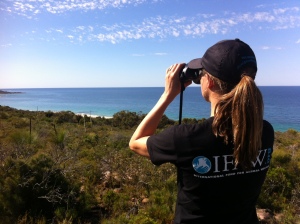 The last month has seen a spur of activity in preparation for CMST’s team organising the theodolite and acoustic components of SouWEST to join WWR and D-CALC in Geographe Bay. Last week saw the commencement of the hilltop whale monitoring season, together with the acoustics and WWR vessel surveys, this year supported by the International Fund for Animal Welfare (IFAW).
The last month has seen a spur of activity in preparation for CMST’s team organising the theodolite and acoustic components of SouWEST to join WWR and D-CALC in Geographe Bay. Last week saw the commencement of the hilltop whale monitoring season, together with the acoustics and WWR vessel surveys, this year supported by the International Fund for Animal Welfare (IFAW).
WWR and the D-CALC volunteers have been conducting whale observations from Pt Piquet since late August and have already sighted their 100th blue whale – so the Curtin University theodolite team was itching to get down and join in! .As the hill observation team joined the seasonal work over a week ago now, with their work focused on the peak of the blue whale season, once again the hills behind Pt Piquet echoed with excited screams as the researchers spotted their first blue whale pods of the season!
Since then we have deployed – for the first time in Geographe Bay – an array of four acoustic loggers, already conducted eight hill-top shifts collecting theodolite tracking and behavioural data, plus one boat-transect of the Bay to investigate humpback and blue whale distribution and photo-ID. This fine-scale information will supplement the long-term monitoring data collected by D-CALC volunteers to provide a ‘big picture’ of how the whales are using Geographe Bay. Although we know that blue and humpback whales are frequently sighted from shore in this area, this year SouWEST is particularly interested in determining the distribution of these animals further out. We will be conducting several boat transect surveys across Geographe Bay to find out where the animals are congregating, and how many of them are around. This information will help us to define the significance of resting and migratory areas in this key habitat for baleen whales. Such results will be important for improving and implementing management guidelines.
Last Saturday was a magical day on the water with almost glassy conditions for the joint WWR and CMST team conducting the first day of boat transect surveys. The team spotted a flurry of wildlife: two groups of blue whales, 24 humpbacks, and the added bonus of sighting three groups of dolphins (one of which were common dolphins), penguins, a bronze whaler, and a New Zealand fur seal throwing a fish around!
Following this, we have now been joined by Sharon Livermore, Marine Campaigner at IFAW. Sharon has been participating in the theodolite tracking as an observer and will also be joining Chris Burton (WWR) and Chandra Salgado-Kent (CMST) out on Chris’s research vessel Bluey to conduct transect surveys. Judging from her enthusiasm up the hill, whale spotting makes a nice change to the office!


